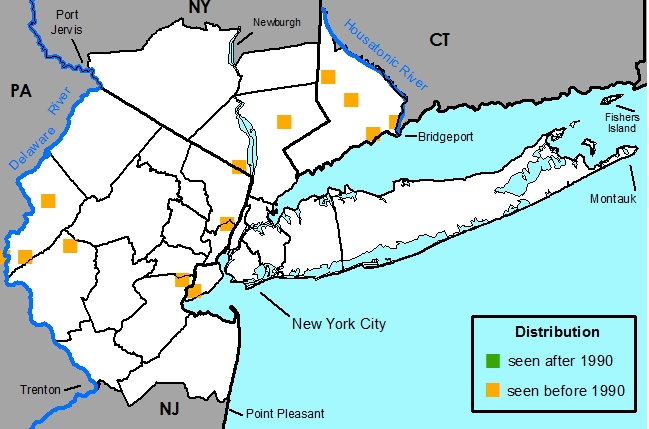Lonicera tatarica L. - Tartarian Honeysuckle
Common Names
Tartarian HoneysuckleField Identification
Deciduous shrub with opposite, simple, entire-margined leaves; with white-pink tubular flowers followed by red-orange berries.Other uses
Used as an ornamental in landscaping situations; introduced into cultivation about 1752 and hardy to USDA zones 3-4.
Poisonous properties
Although the berries of some species are known to be edible; generally, ingestion of the fruit causes mild to moderate nausea, vomiting, and diarrhea; death is unlikely.
Nomenclature
Lonicera tatarica L., Sp. Pl. 173. 1753.Xylosteon cordatum Moench, Meth. Pl. 502. 1794.
Xylosteum tartaricum Medicus, Beytr. Pflanzen.-Anat. 97. 1799.
Chamaecerasus tartaricus Medicus, Beytr. Pflanzen.-Anat. 390. 1800.
Xylosteon tartaricum Dumont de Courset, Bot. Cult. 2: 575. 1802.
Xylosteum tataricum Borkh., Theor-prakt. Handb. Forstbot. 2: 1681. 1803.
Lonicera pyrenaica hort. ex Regel, Gartenfl.18: 258. 1869, non L. 1753.
Lonicera discolor hort. ex Regel, Gartenfl.18: 258. 1869, non Lindley 1844.
Caprifolium tataricum Kuntze, Rev. Gen. Pl. 1: 274. 1891.
TYPE: unknown
Description
HABIT Perennial, deciduous, phanerophytic, shrub, monoclinous, 1-3 m tall.STEMS Main stems ascending or erect, round. Bark furrowed or fibrous, exfoliating or not exfoliating, gray. Branches ascending or horizontal. Twigs gray, not odoriferous, terete, 1-5 mm in diam., smooth (older twigs fibrous), glabrous, eglandular. Pith absent, nodal diaphragm absent. Sap translucent. For a detailed analysis of the root anatomy see Gasson, 1979.
BUDS Terminal and axillary present, monomorphic, scattered along stem; terminal bud ovoid, pointed; axillary buds 1-2 per axil, ovoid, pointed, often superposed. Bud scales light brown, imbricate, glabrous or with short and unbranched hairs, distributed marginally, eglandular. Bud scale scars not encircling the stem. Leaf scars thinly crescent-shaped. Vascular bundle scars 3.
LEAVES Opposite, simple, spiral, 2 per node, spaced somewhat evenly along stem, divergent from stem. Stipules absent. Leaves petiolate, petiole furrowed, 0.4-0.8 cm long, glabrous, eglandular. Leaf blades: abaxial surface light green, adaxial surface green, lanceolate or oblong or ovate, bilaterally symmetric, 2.5-6.5 cm long, 1.5-3.5 cm wide, base obtuse or subcordate, margin entire or ciliate, apex acute or obtuse, abaxial surface glabrous or with long and unbranched hairs, erect or spreading, white or light gray, sparse, distributed throughout, eglandular. Adaxial surface glabrous, eglandular.
INFLORESCENCES Bisexual, axillary 2-flowered cyme. Peduncle 1.5-2.5 cm long, glabrous; often tinged rose-pink. Rachis absent, flowers sessile at apex of peduncle. Bracts sessile, green, linear triangular, 3-8 mm long, 1 mm wide, margin entire, apex acute, eglandular, glabrous; often tinged rose-pink; occasionally with minute marginal glands. Bracteoles 2, green, often tinged rose-pink, 1 mm long, 1 mm wide, less than 1/2 length of the ovary, margin entire, apex obtuse, glabrous, eglandular or occasionally with minute marginal glands.
FLOWERS Serotinous, formed on last season's growth, bisexual, with sepals and petals readily distinguishable from one another, 5-merous, 2 flowers per inflorescence. Calyx actinomorphic, of fused sepals, persistent, abaxial and adaxial light yellowish green or light green. Sepal lobes 5, shallowly triangular, margin entire, apex acute or obtuse, glabrous, eglandular, often tinged rose-pink; occasionally with minute marginal glands. Corolla zygomorphic, infundibuliform, of fused petals, deciduous, abaxial and adaxial surfaces red or pink or white (sometimes turning yellow after anthesis), 15-20 mm long, slightly gibbous at base. Petal lobes 5, often darker-colored than throat. Margin entire, apex obtuse, abaxial surface glabrous, eglandular, adaxial surface glabrous, eglandular. Gynoecium syncarpous. Locules 2-3. Stigmas 1, capitate. Styles 1, with long unbranched hairs. Ovary inferior, glabrous, eglandular. Placentation axile. Androecium epipetalous, exserted, haplostemous, inserted near the top of the corolla tube. Stamens 5. Anthers opening along the long axis, yellow, glabrous, eglandular. Filaments straight, light yellow or white, glabrous. For a detailed analysis of the flower micro-anatomy and vascularization see Wilkinson, 1948.
FRUITS Bacca, red or orange-red, globose, 5-6 mm in diameter, glabrous, eglandular. For a review of infructescence development and morphology see Malinkina, 2002(In Russian).
SEEDS Seeds 2 to 8, orange-red, ovoid, 2.5-3.5 mm long, 2-2.5 mm wide, glabrous, eglandular, reticulate-foveate.
Habitat
Found in dry to moist situations including woods, thickets, fields, roadsides, and swamps.Distribution
Indigenous to central Asia, from southern Russia to Altai and Turkistan; naturalized in northern North America.United States -- AK, CA, CO, CT, DE, IA, IL, IN, KS, KY, MA, MD, ME, MI, MN, MO?, MT, ND, NH, NJ, NY, OH, PA, RI, SD, UT, VA, VT, WI, WV, WY
Canada -- AB, MB, NB, NS, ON, QC, SK
New York Metropolitan Region -- Nonnative, occasionally naturalized throughout the metropolitan area.
Rarity Status
Global Heritage Rank -- G5Species Biology
FloweringMay [week 1] - June [week 2]
Pollination
Mellitophily -- Andrena?, Bombus, Halictus, Megachile, Osmia
Mycophily -- Mesogramma
Phalaenophily -- Hemaris
Ornithophily -- Trochilus
Fruiting
June [week 4] - September [week 1]
Dispersal
(White, 1992) (Sherburne, 1972) (McRae, 1980) (Ingold, 1983)
Endozoochory -- Avian frugivores: Turdus migratorius (Robin), Bombycilla cedrorum (Cedar Waxwing), Pheucticus ludovicianus (Rose-breasted Grosbeak), Dumetella carolinensis (Catbird), Icterus galbula (Baltimore Oriole), Cyanocitta cristata (Blue Jay), Pipilo spp. (Towhee), Agelaius phoeniceus (Red-winged Blackbird), Molothrus ater (Cowbird), Sturnus vulgaris (Starling), Catharus fuscescens (Veery Thrush), Colinus virginianus (Bobwhite Quail) Catharus minima (Gray-cheeked Trush), Catharus ustulatus (Swainson's Thrush), Cardinalis cardinalis (Cardinal), Carpodacus purpureus (Purple Finch), Carduelis tristis (Goldfinch), Zonotrichia albicollis (White-throated Sparrow), Mimus polyglottus (Mockingbird), Dendroica coronata?(Yellow-rumped Warbler), Toxosoma rufum? (Brown Thrasher)
Mammals: Odocoileus virginianus (White-tailed deer) (Vellend, 2002)
Germination
(Schopmeyer, 1974) (Krefting, 1949)
Natural germination is believed to occur in the spring following autumn/winter dispersal. Avian frugivores have shown to improve germination. Germination is epigeous. This species sometimes exhibits embryo dormancy, other times an impermeable seed coat retards germination. Stratification in moist sand or peat at 41 degrees F for 60 days might be beneficial for the first type; for those of the second type a period of moist stratification at 68[night] - 86[day] degrees F for 60-90 days followed by a period of moist stratification at 41 degrees F for 30-60 days might be helpful. Possibly light scarification can be substituted for the warm stratification. While definite information for the optimum storage of Lonicera seeds is lacking; generally, seed stored in a sealed container at 41 degrees F should remain viable for at least one year.
